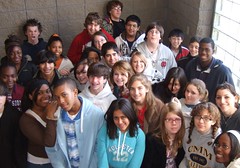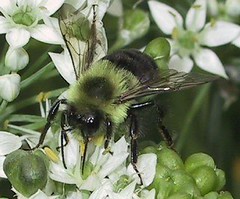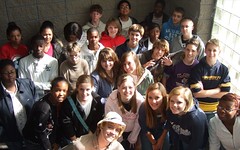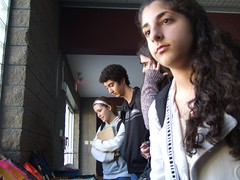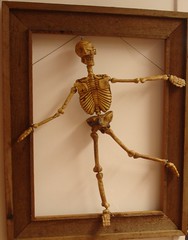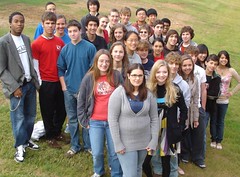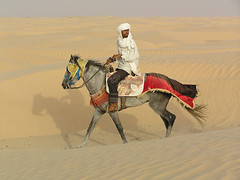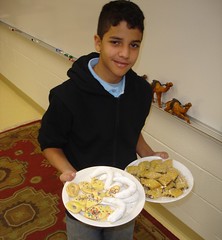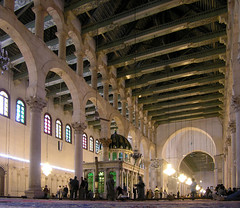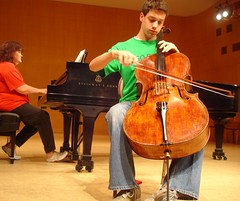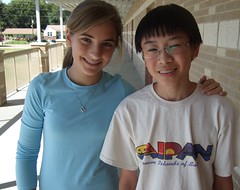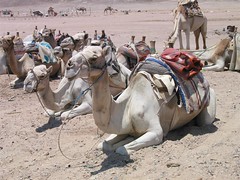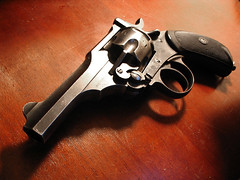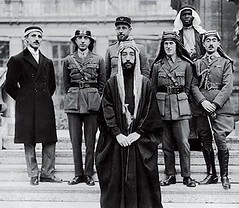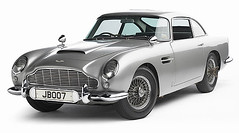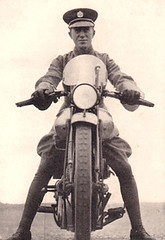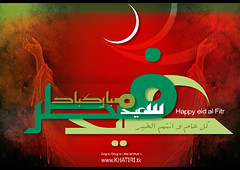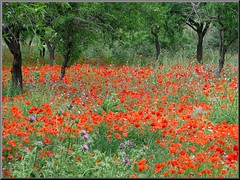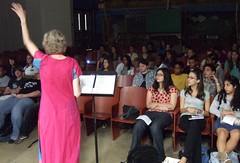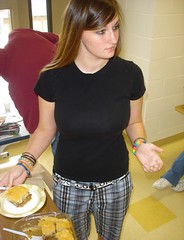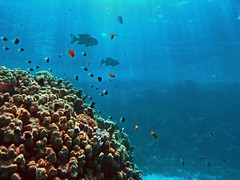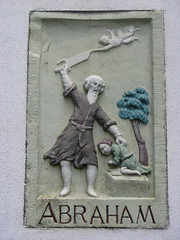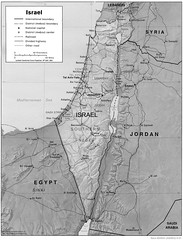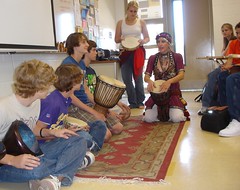Map of India:
Delhi
Arabian Sea
Indian Ocean
Bay opf Bengal
Pakistan
Bangladesh
Afghanistan
Star and crescent: Muslim nations of Pakistan, Bangladesh, Afghanistan.
Wheel of life: symbol of India and of Hinduism.
Mandala: wheel; wheel of life.
Om: a symbol similar to the numeral 3. A Sanskrit symbol for Hinduism.
Swastike: Chinese and Indian symbol for good fortune.
Diwali, festival of lights - see other post.
Laxmi, goddess of wealth.
Bindi: red dot on forehead.
Sitar: multi-stringed guitar-like instrument.
henna: dye used in hands and face to make a temporary form of tattoo.
guru: master or teacher.
Curry powder: cumin, cardamom, coriander, fenugreek, mace, dill, ginger, turmeric, cloves, red and black pepper.
Wednesday, October 31, 2007
Tuesday, October 30, 2007
Questioning praise; where's the wise stance in regards kudos?
An excess of praise may be doing kids more harm than good, says the NY Times:
A cover story in this month’s Scholastic Instructor magazine asks whether kids today are “overpraised.'’ The concern is that by focusing on self-esteem and confidence building, parents and teachers may be giving real goals and achievement short shrift. The article cites a recent study in which eighth graders in Korea and the United States were asked whether they were good at math. Among the American students, 39 percent said they were excellent at math, compared to just 6 percent of the Korean eighth graders. But the reality was somewhat different. The Korean kids scored far better in math than the over-confident American students.
The notion that you can praise a kid too much is heresy to parents and teachers who have long believed that building self-esteem should be the cornerstone of education. If kids believe in themselves, the thinking goes, achievement will naturally follow. But confidence doesn’t always produce better students.
A cover story in this month’s Scholastic Instructor magazine asks whether kids today are “overpraised.'’ The concern is that by focusing on self-esteem and confidence building, parents and teachers may be giving real goals and achievement short shrift. The article cites a recent study in which eighth graders in Korea and the United States were asked whether they were good at math. Among the American students, 39 percent said they were excellent at math, compared to just 6 percent of the Korean eighth graders. But the reality was somewhat different. The Korean kids scored far better in math than the over-confident American students.
The notion that you can praise a kid too much is heresy to parents and teachers who have long believed that building self-esteem should be the cornerstone of education. If kids believe in themselves, the thinking goes, achievement will naturally follow. But confidence doesn’t always produce better students.
Monday, October 29, 2007
Bee colony collapse threatening future food supplies
Many fruit, vegetable and seed crops, worth between $8 billion and $12 billion each year, rely on honeybees for pollination.
ScienceDaily (2007) — Scientists are working hard to understand the sources of a staggering decline in honeybees in as many as 27 U.S. states and countries in Europe and Asia this winter, said Cornell associate professor of entomology Nicholas Calderone.
For the past year, experts have observed a marked decline in the honey bee population, with entire colonies collapsing without warning. Approximately 50 percent of hives have disappeared and researchers around the country are scrambling to find out why. Scientists have termed this phenomenon "Colony Collapse Disorder" and fear that without honey bees to pollinate crops like fruits, vegetables, and almonds the loss of honey bees could have an enormous horticultural and economic impact around the world.
Says the PBS program Nature, "In the winter of 2006/2007, more than a quarter of the country's 2.4 million bee colonies -- accounting for tens of billions of bees -- were lost to CCD, Colony Collapse Disorder. This loss is projected have an $8 billion to $12 billion effect on America's agricultural economy, but the consequences of CCD could be far more disastrous.
The role honeybees play in our diet goes beyond honey production. These seemingly tireless creatures pollinate about one-third of crop species in the U.S.
Honeybees pollinate about 100 flowering food crops including apples, nuts, broccoli, avocados, soybeans, asparagus, celery, squash and cucumbers, citrus fruit, peaches, kiwi, cherries, blueberries, cranberries, strawberries, cantaloupe, melons, as well as animal-feed crops, such as the clover that's fed to dairy cows. Essentially all flowering plants need bees to survive.
A daunting question is: If honeybee colonies were so severely affected by CCD that pollination stopped, could we lose these crops from our markets and our diets forever?"
ScienceDaily (2007) — Scientists are working hard to understand the sources of a staggering decline in honeybees in as many as 27 U.S. states and countries in Europe and Asia this winter, said Cornell associate professor of entomology Nicholas Calderone.
For the past year, experts have observed a marked decline in the honey bee population, with entire colonies collapsing without warning. Approximately 50 percent of hives have disappeared and researchers around the country are scrambling to find out why. Scientists have termed this phenomenon "Colony Collapse Disorder" and fear that without honey bees to pollinate crops like fruits, vegetables, and almonds the loss of honey bees could have an enormous horticultural and economic impact around the world.
Says the PBS program Nature, "In the winter of 2006/2007, more than a quarter of the country's 2.4 million bee colonies -- accounting for tens of billions of bees -- were lost to CCD, Colony Collapse Disorder. This loss is projected have an $8 billion to $12 billion effect on America's agricultural economy, but the consequences of CCD could be far more disastrous.
The role honeybees play in our diet goes beyond honey production. These seemingly tireless creatures pollinate about one-third of crop species in the U.S.
Honeybees pollinate about 100 flowering food crops including apples, nuts, broccoli, avocados, soybeans, asparagus, celery, squash and cucumbers, citrus fruit, peaches, kiwi, cherries, blueberries, cranberries, strawberries, cantaloupe, melons, as well as animal-feed crops, such as the clover that's fed to dairy cows. Essentially all flowering plants need bees to survive.
A daunting question is: If honeybee colonies were so severely affected by CCD that pollination stopped, could we lose these crops from our markets and our diets forever?"
Notes on Lawrence, England, camels, Lowell Thomas, etc. on the Tues quiz.
"Lawrence: from Oxford to Damascus."
In class on Mon students wrote a brief essay on Lawrence's trek. They will get 5 pts for it tomorrow.
In it they explain his 1915 - 1918 journey by quickly describing his work in 6 locations, which includes Oxford and Damascus. .
Vocab . . .
- frankincense, product of Arabia
- censer, used to purify the altar in numerous religions via sweet-smelling smoke.
- acolyte - altar boy
parochial - "from the parish," or "from the country." Thus narrow-minded, ill-educated.
cosmopolitan - :polis, "citizen" of the cosmos, or "universe."
Thus a person open to new ideas, to education, to change.
In class on Mon students wrote a brief essay on Lawrence's trek. They will get 5 pts for it tomorrow.
In it they explain his 1915 - 1918 journey by quickly describing his work in 6 locations, which includes Oxford and Damascus. .
Vocab . . .
- frankincense, product of Arabia
- censer, used to purify the altar in numerous religions via sweet-smelling smoke.
- acolyte - altar boy
parochial - "from the parish," or "from the country." Thus narrow-minded, ill-educated.
cosmopolitan - :polis, "citizen" of the cosmos, or "universe."
Thus a person open to new ideas, to education, to change.
Special events week: Rally on Wed, Homecoming picnic on Fri, Nov 2
Harvest holiday week . . .
Wed.
the Halloween assembly is 10:15 - 10:45 in the gym.
Fri.
the Homecoming Picnic is from 11:30 - 2 pm.
At the picnic, clubs will sell all manner of food and drink for $1 to $3 per item. Students should dress for activities such as the inflatable slide, DDR and hanging out on the quadrangle.
Hopefully you will shoot lots of photos and make new friends in this magical celebration.
Class of 2011 will have a booth selling pizza by the slice for 1$.
Wed.
the Halloween assembly is 10:15 - 10:45 in the gym.
Fri.
the Homecoming Picnic is from 11:30 - 2 pm.
At the picnic, clubs will sell all manner of food and drink for $1 to $3 per item. Students should dress for activities such as the inflatable slide, DDR and hanging out on the quadrangle.
Hopefully you will shoot lots of photos and make new friends in this magical celebration.
Class of 2011 will have a booth selling pizza by the slice for 1$.
Week of Oct 29 - Nov 2: Lawrence of Arabia test Tues.
"I just want my ration of common humanity!" Lawrence after being tortured by the Turks and having burned out on leading the Arab revolt.
Based on web site notes, the Lawrence test, open-notes and multiple choice, will be Tues.
Who took over the Middle East after WWI? The region was divided between the British and the French.
Based on web site notes, the Lawrence test, open-notes and multiple choice, will be Tues.
Who took over the Middle East after WWI? The region was divided between the British and the French.
Friday, October 26, 2007
Social Studies Fair competition at CMHS on Jan 17
All students will write a brief paper using the elements of a social studies research paper. I'll issue more details and a deadline next week. Only students with unusual motivation will make a project for the SS Fair.
The basics:
Question. Any good project begins with a question.
- Should I buy stock in WalMart?
- Is there a workable solution for ameliorating tensions between Muslim and non-Muslim students at my school?
Hypothesis.
A thoughtful guess as to what should be done is called a hypothesis.
- If I look at the record of Walmart stock and examine the executive team, it should be a good bet.
- A once-a-semester school-wide meeting with presentations by students and Q & A with Muslim students in the PAC might produce results.
Research.
- WalMart's future propects will be researched by reading articles in these magazines - Fortune, Economist, Business Week - and these newspapers - Wall St Journal, NY Times. Add interviews with a stockbroker and WalMart store manager.
- A planning committee of students and teachers - non-Muslim as well as Muslim - will design the elements of the program. A paper on the difficulties of Muslim-Americans will be resarched and presented to the committee.
Documentation.
A bibliography; a list of all sources examined in the quest.
Evaluation.
- Watch the WalMart stock for a month or more. Make a judgement about the stock's future based on your observations.
- A questionnaire with multiple-choice questions might be used to evaluate any changes perceived by the participants after taking part in the Muslim attitudes conference.
Topics . . .
history
geography
sociology
anthropology
I will approve all topics and and give guidance as students embark on the project. More details next week.
The basics:
Question. Any good project begins with a question.
- Should I buy stock in WalMart?
- Is there a workable solution for ameliorating tensions between Muslim and non-Muslim students at my school?
Hypothesis.
A thoughtful guess as to what should be done is called a hypothesis.
- If I look at the record of Walmart stock and examine the executive team, it should be a good bet.
- A once-a-semester school-wide meeting with presentations by students and Q & A with Muslim students in the PAC might produce results.
Research.
- WalMart's future propects will be researched by reading articles in these magazines - Fortune, Economist, Business Week - and these newspapers - Wall St Journal, NY Times. Add interviews with a stockbroker and WalMart store manager.
- A planning committee of students and teachers - non-Muslim as well as Muslim - will design the elements of the program. A paper on the difficulties of Muslim-Americans will be resarched and presented to the committee.
Documentation.
A bibliography; a list of all sources examined in the quest.
Evaluation.
- Watch the WalMart stock for a month or more. Make a judgement about the stock's future based on your observations.
- A questionnaire with multiple-choice questions might be used to evaluate any changes perceived by the participants after taking part in the Muslim attitudes conference.
Topics . . .
history
geography
sociology
anthropology
I will approve all topics and and give guidance as students embark on the project. More details next week.
Thursday, October 25, 2007
Some ideas from The Economist on enhancing educational achievement
"According to the National Foundation for Education Research," says the Brtish news magazine The Economist, "there had been (until recently) no measurable improvement in the standards of literacy and numeracy in primary schools for 50 years."
Following are excerpts from the article, "What works in education: the lessons according to McKinsey."
Australia has almost tripled education spending per student since 1970. No improvement. American spending has almost doubled since 1980 and class sizes are the lowest ever. Again, nothing. No matter what you do, it seems, standards refuse to budge (see chart). To misquote Woody Allen, those who can't do, teach; those who can't teach, run the schools.
There are big variations in educational standards between countries. These have been measured and re-measured by the OECD's Programme for International Student Assessment (PISA) which has established, first, that the best performing countries do much better than the worst and, second, that the same countries head such league tables again and again:
Canada,
Finland,
Japan,
Singapore,
South Korea.
what do the successful lot have in common? Yet the answer to that has proved surprisingly elusive. Not more money. Singapore spends less per student than most. Nor more study time. Finnish students begin school later, and study fewer hours, than in other rich countries.
Schools, it says*, need to do three things: get the best teachers; get the best out of teachers; and step in when pupils start to lag behind. That may not sound exactly “first-of-its-kind”: schools surely do all this already? Actually, they don't. If these ideas were really taken seriously, they would change education radically.
There is no question that, as one South Korean official put it, “the quality of an education system cannot exceed the quality of its teachers.” Studies in Tennessee and Dallas have shown that, if you take pupils of average ability and give them to teachers deemed in the top fifth of the profession, they end up in the top 10% of student performers; if you give them to teachers from the bottom fifth, they end up at the bottom. The quality of teachers affects student performance more than anything else.
Almost every rich country has sought to reduce class size lately. Yet all other things being equal, smaller classes mean more teachers for the same pot of money, producing lower salaries and lower professional status. That may explain the paradox that, after primary school, there seems little or no relationship between class size and educational achievement.
You might think that schools should offer as much money as possible, seek to attract a large pool of applicants into teacher training and then pick the best. Not so, says McKinsey. If money were so important, then countries with the highest teacher salaries—Germany, Spain and Switzerland—would presumably be among the best. They aren't. In practice, the top performers pay no more than average salaries.
For understandable reasons, teachers rarely get much training in their own classrooms (in contrast, doctors do a lot of training in hospital wards). But successful countries can still do much to overcome the difficulty.
Singapore provides teachers with 100 hours of training a year and appoints senior teachers to oversee professional development in each school. In Japan and Finland, groups of teachers visit each others' classrooms and plan lessons together. In Finland, they get an afternoon off a week for this. In Boston, which has one of America's most improved public-school systems, schedules are arranged so that those who teach the same subject have free classes together for common planning. This helps spread good ideas around. As one educator remarked, “when a brilliant American teacher retires, almost all of the lesson plans and practices that she has developed also retire. When a Japanese teacher retires, she leaves a legacy.”
For the past few years, almost all countries have begun to focus more attention on testing, the commonest way to check if standards are falling. McKinsey's research is neutral on the usefulness of this, pointing out that while Boston tests every student every year, Finland has largely dispensed with national examinations. Similarly, schools in New Zealand and England and Wales are tested every three or four years and the results published, whereas top-of-the-class Finland has no formal review and keeps the results of informal audits confidential.
But there is a pattern in what countries do once pupils and schools start to fail. The top performers intervene early and often. Finland has more special-education teachers devoted to laggards than anyone else—as many as one teacher in seven in some schools. In any given year, a third of pupils get one-on-one remedial lessons. Singapore provides extra classes for the bottom 20% of students and teachers are expected to stay behind—often for hours—after school to help students.
Following are excerpts from the article, "What works in education: the lessons according to McKinsey."
Australia has almost tripled education spending per student since 1970. No improvement. American spending has almost doubled since 1980 and class sizes are the lowest ever. Again, nothing. No matter what you do, it seems, standards refuse to budge (see chart). To misquote Woody Allen, those who can't do, teach; those who can't teach, run the schools.
There are big variations in educational standards between countries. These have been measured and re-measured by the OECD's Programme for International Student Assessment (PISA) which has established, first, that the best performing countries do much better than the worst and, second, that the same countries head such league tables again and again:
Canada,
Finland,
Japan,
Singapore,
South Korea.
what do the successful lot have in common? Yet the answer to that has proved surprisingly elusive. Not more money. Singapore spends less per student than most. Nor more study time. Finnish students begin school later, and study fewer hours, than in other rich countries.
Schools, it says*, need to do three things: get the best teachers; get the best out of teachers; and step in when pupils start to lag behind. That may not sound exactly “first-of-its-kind”: schools surely do all this already? Actually, they don't. If these ideas were really taken seriously, they would change education radically.
There is no question that, as one South Korean official put it, “the quality of an education system cannot exceed the quality of its teachers.” Studies in Tennessee and Dallas have shown that, if you take pupils of average ability and give them to teachers deemed in the top fifth of the profession, they end up in the top 10% of student performers; if you give them to teachers from the bottom fifth, they end up at the bottom. The quality of teachers affects student performance more than anything else.
Almost every rich country has sought to reduce class size lately. Yet all other things being equal, smaller classes mean more teachers for the same pot of money, producing lower salaries and lower professional status. That may explain the paradox that, after primary school, there seems little or no relationship between class size and educational achievement.
You might think that schools should offer as much money as possible, seek to attract a large pool of applicants into teacher training and then pick the best. Not so, says McKinsey. If money were so important, then countries with the highest teacher salaries—Germany, Spain and Switzerland—would presumably be among the best. They aren't. In practice, the top performers pay no more than average salaries.
For understandable reasons, teachers rarely get much training in their own classrooms (in contrast, doctors do a lot of training in hospital wards). But successful countries can still do much to overcome the difficulty.
Singapore provides teachers with 100 hours of training a year and appoints senior teachers to oversee professional development in each school. In Japan and Finland, groups of teachers visit each others' classrooms and plan lessons together. In Finland, they get an afternoon off a week for this. In Boston, which has one of America's most improved public-school systems, schedules are arranged so that those who teach the same subject have free classes together for common planning. This helps spread good ideas around. As one educator remarked, “when a brilliant American teacher retires, almost all of the lesson plans and practices that she has developed also retire. When a Japanese teacher retires, she leaves a legacy.”
For the past few years, almost all countries have begun to focus more attention on testing, the commonest way to check if standards are falling. McKinsey's research is neutral on the usefulness of this, pointing out that while Boston tests every student every year, Finland has largely dispensed with national examinations. Similarly, schools in New Zealand and England and Wales are tested every three or four years and the results published, whereas top-of-the-class Finland has no formal review and keeps the results of informal audits confidential.
But there is a pattern in what countries do once pupils and schools start to fail. The top performers intervene early and often. Finland has more special-education teachers devoted to laggards than anyone else—as many as one teacher in seven in some schools. In any given year, a third of pupils get one-on-one remedial lessons. Singapore provides extra classes for the bottom 20% of students and teachers are expected to stay behind—often for hours—after school to help students.
All A's in 5th hour geography class: Karen Ezelle, Joseph Reynolds, Kirsten Armentrout, Shreveport
Congrats to this trio, too!
Wednesday, October 24, 2007
Lawrence of Arabia test to be given at end of movie viewing
Notes from Lawrence of Arabia . . .
Arabs and hospitality:
owing partly to the harsh environment of the desert, Arabs are famed for their welcoming spirit. Lawrence knew about this cultural factor and used it to avoid conflict between the Howeitat (Auda Abu Tayi) and the Harith (Sherif Ali) tribes.
effendi: term of respect, like Mister or Sir.
mustapha: European name for any Arab or Turkish fellow.
Themes at work:
- the duplicity of the military bureaucracy.
- men's cruelties justified by war.
- men change; power corrupts.
- cultures are mostly resistant to change.
The tragedy of the war of the Arabs vs. the Turks was that an Arab victory did not win them their independence. The Arabs could not govern themselves in Damascus. The British and French therefore
divided the Middle East and took control.
Arab confusion in Damascus was based on
- lack of practice in administering a unified government.
- lack of knowledge in urban technology such as water and electrical systems and in hospital management.
- absence of a leader with the power to enforce his control.
Independent work:
Research and compare Islam and Hinduism.
Arabs and hospitality:
owing partly to the harsh environment of the desert, Arabs are famed for their welcoming spirit. Lawrence knew about this cultural factor and used it to avoid conflict between the Howeitat (Auda Abu Tayi) and the Harith (Sherif Ali) tribes.
effendi: term of respect, like Mister or Sir.
mustapha: European name for any Arab or Turkish fellow.
Themes at work:
- the duplicity of the military bureaucracy.
- men's cruelties justified by war.
- men change; power corrupts.
- cultures are mostly resistant to change.
The tragedy of the war of the Arabs vs. the Turks was that an Arab victory did not win them their independence. The Arabs could not govern themselves in Damascus. The British and French therefore
divided the Middle East and took control.
Arab confusion in Damascus was based on
- lack of practice in administering a unified government.
- lack of knowledge in urban technology such as water and electrical systems and in hospital management.
- absence of a leader with the power to enforce his control.
Independent work:
Research and compare Islam and Hinduism.
Lowell Thomas and the role of journalists in western society
We call it the Free press . . .
Amendment 1 - Freedom of Religion, Press, Expression. Ratified 12/15/1791
Congress shall make no law respecting an establishment of religion, or prohibiting the free exercise thereof; or abridging the freedom of speech, or of the press; or the right of the people peaceably to assemble, and to petition the Government for a redress of grievances.
The role of journalists in the adversary system of American democracy should not be underestimated. The system of checks (stops) and balances that exists between Congress, the executive branch and the judiciary has an additional element: oversight by the media.
In the pre-Watergate era the press ignored Presidents' girlfriends and congressmen's drinking problems.
Perhaps because of the lies told repeatedly by President Nixon during the Watergate investigation (1972 - 1974), the media has sent been zealous in examining the lives of the powerful, extending to their personal lives.
Is the US media truly free? All that men print or mention in the media is subject to threat by big money. If an influential man does not want a story to be aired by the media there are several ways to bring pressure to bear. One of the chief forms of leverage is to convince advertisers not to take ads in the media. That cuts off the income that media companies need for survival. Money speaks!
Conversely, powerful people can make sure that certain stories Will appear in the media. Lowell Thomas wrote stories about the dashing Lawrence and the underdog Arabs so as to influence Americans to feel more passion about the war against Germany, said Thomas. He wrote them, he said, at the request of powerful people.
Amendment 1 - Freedom of Religion, Press, Expression. Ratified 12/15/1791
Congress shall make no law respecting an establishment of religion, or prohibiting the free exercise thereof; or abridging the freedom of speech, or of the press; or the right of the people peaceably to assemble, and to petition the Government for a redress of grievances.
The role of journalists in the adversary system of American democracy should not be underestimated. The system of checks (stops) and balances that exists between Congress, the executive branch and the judiciary has an additional element: oversight by the media.
In the pre-Watergate era the press ignored Presidents' girlfriends and congressmen's drinking problems.
Perhaps because of the lies told repeatedly by President Nixon during the Watergate investigation (1972 - 1974), the media has sent been zealous in examining the lives of the powerful, extending to their personal lives.
Is the US media truly free? All that men print or mention in the media is subject to threat by big money. If an influential man does not want a story to be aired by the media there are several ways to bring pressure to bear. One of the chief forms of leverage is to convince advertisers not to take ads in the media. That cuts off the income that media companies need for survival. Money speaks!
Conversely, powerful people can make sure that certain stories Will appear in the media. Lowell Thomas wrote stories about the dashing Lawrence and the underdog Arabs so as to influence Americans to feel more passion about the war against Germany, said Thomas. He wrote them, he said, at the request of powerful people.
Guidelines for eating in the classrooms
First of all, Caddo rules prohibit eating in the classroom. Administrators, however, may make exceptions where needed for academic purpose.
Ms Rounds new guidelines for study-related tastes at school require us to have written slips from parents giving the teacher permission to feed the students. And ingredients for a dish must be published. Happily, my students routinely explain the ingredients - under my questioning, at the very least - as they serve a dish related to a foreign culture.
My guidelines include -
* something easy to serve; a cold dish.
* a dish that expands tastebuds a bit; not something that is commonly consumed.
* explantion of ingredients, source of recipe and its place in the culture.
* that we are scrupulously neat in serving and clean up.
Ms Rounds new guidelines for study-related tastes at school require us to have written slips from parents giving the teacher permission to feed the students. And ingredients for a dish must be published. Happily, my students routinely explain the ingredients - under my questioning, at the very least - as they serve a dish related to a foreign culture.
My guidelines include -
* something easy to serve; a cold dish.
* a dish that expands tastebuds a bit; not something that is commonly consumed.
* explantion of ingredients, source of recipe and its place in the culture.
* that we are scrupulously neat in serving and clean up.
Tuesday, October 23, 2007
Damascus, capital of Syria, was the ultimate jewel in the Arab-Turk conflict in WWI
Terminology from Lawrence of Arabia:
- Monte Carlo, Monaco
Casinos (houses), Grand Prix de Monaco, Grace Kelly, $$$
- Sinai peninsula or desert
Joseph, Mary & Jesus trekked the Sinai in their journey to Egypt.
Most communities are in the stone canyons called wadis.
- Geneva Convention
Agreements between nations on treatment of Prisoners of War.
Access given to Intl. Red Cross. Torture limited.
Geneva, Switzerland.
- Damascus, Syria: center of Muslim world in WWI era.
- Caucasus Mts.: in 1800's was thought to be place of origin of
European people. It is in Western Asia, between the Black Sea
and Caspian.
Mercenary: soldier for hire. Ex: Blackwater Corp.
Insh'allah: "God willing."
Independent work:
Research, document and compare the lives of TE Lawrence and
Prince Feisel (Faisal) of Mecca.
Or compare Lawrence and Lowell Thomas, the successful reporter.
- Monte Carlo, Monaco
Casinos (houses), Grand Prix de Monaco, Grace Kelly, $$$
- Sinai peninsula or desert
Joseph, Mary & Jesus trekked the Sinai in their journey to Egypt.
Most communities are in the stone canyons called wadis.
- Geneva Convention
Agreements between nations on treatment of Prisoners of War.
Access given to Intl. Red Cross. Torture limited.
Geneva, Switzerland.
- Damascus, Syria: center of Muslim world in WWI era.
- Caucasus Mts.: in 1800's was thought to be place of origin of
European people. It is in Western Asia, between the Black Sea
and Caspian.
Mercenary: soldier for hire. Ex: Blackwater Corp.
Insh'allah: "God willing."
Independent work:
Research, document and compare the lives of TE Lawrence and
Prince Feisel (Faisal) of Mecca.
Or compare Lawrence and Lowell Thomas, the successful reporter.
Lowell Thomas, acclaimed journalist, was writer who hyped the Life of Lawrence: his book called With Lawrence In Arabia
Lowell Jackson Thomas (April 6, 1892 – August 29, 1981) was an American writer, broadcaster, and traveller best known as the man who made Lawrence of Arabia famous, says wikipedia.
He received both a B.A. and an M.A. from the University of Denver and began work for the Chicago Journal, writing for it until 1914. While in Chicago, he was a professor at the Chicago-Kent College of Law, teaching oratory. He then went to New Jersey, where he studied for a master's at Princeton University (he received the degree in 1916) and again taught oratory at the university.
When the United States entered World War I, he was part of an official party sent by President Wilson, former president of Princeton, to "compile a history of the conflict." In reality the mission was not academic. The war was not popular in the United States, and Thomas was sent to find material that would encourage the American people to support it. Thomas did not want to merely write about the war, he wanted to film it. He estimated that $75,000 would be needed for filming, which the U.S. government thought too expensive, and so he turned to a group of 18 Chicago meat packers. (He had done them a favor by exposing someone who was blackmailing them, without the damaging material becoming public.)
He and a cameraman, Harry Chase, first went to the Western Front, but the trenches had little to inspire the American public. They then went to Italy, where he heard of General Allenby's campaign against the Ottoman Empire in Palestine. With the permission of the British Foreign Office, as an accredited war-correspondent, Thomas met T. E. Lawrence, a captain in the British Army in Jerusalem. Lawrence was spending £200,000 a month encouraging the inhabitants of Palestine to revolt against the Turks. Thomas and Chase spent several weeks with Lawrence in the desert, though Lawrence said "several days."
Thomas shot dramatic footage of Lawrence and, after the war, toured the world, narrating his film, With Allenby in Palestine and Lawrence in Arabia, making Lawrence—and himself—household names. The performances were highly dramatic. At the opening of Thomas's six-month London run, there were incense braziers, exotically dressed women danced before images of the Pyramids, and the band of the Welsh Guards played to provide the accompaniment.
Lawrence saw the show several times, and though he later claimed to dislike it, it generated valuable publicity for his own book.
About four million people saw the show around the world, and it made Thomas $1.5 million. Thomas would also later write a book, With Lawrence in Arabia (1924), about his time in the desert and Lawrence's exploits during the war.
He received both a B.A. and an M.A. from the University of Denver and began work for the Chicago Journal, writing for it until 1914. While in Chicago, he was a professor at the Chicago-Kent College of Law, teaching oratory. He then went to New Jersey, where he studied for a master's at Princeton University (he received the degree in 1916) and again taught oratory at the university.
When the United States entered World War I, he was part of an official party sent by President Wilson, former president of Princeton, to "compile a history of the conflict." In reality the mission was not academic. The war was not popular in the United States, and Thomas was sent to find material that would encourage the American people to support it. Thomas did not want to merely write about the war, he wanted to film it. He estimated that $75,000 would be needed for filming, which the U.S. government thought too expensive, and so he turned to a group of 18 Chicago meat packers. (He had done them a favor by exposing someone who was blackmailing them, without the damaging material becoming public.)
He and a cameraman, Harry Chase, first went to the Western Front, but the trenches had little to inspire the American public. They then went to Italy, where he heard of General Allenby's campaign against the Ottoman Empire in Palestine. With the permission of the British Foreign Office, as an accredited war-correspondent, Thomas met T. E. Lawrence, a captain in the British Army in Jerusalem. Lawrence was spending £200,000 a month encouraging the inhabitants of Palestine to revolt against the Turks. Thomas and Chase spent several weeks with Lawrence in the desert, though Lawrence said "several days."
Thomas shot dramatic footage of Lawrence and, after the war, toured the world, narrating his film, With Allenby in Palestine and Lawrence in Arabia, making Lawrence—and himself—household names. The performances were highly dramatic. At the opening of Thomas's six-month London run, there were incense braziers, exotically dressed women danced before images of the Pyramids, and the band of the Welsh Guards played to provide the accompaniment.
Lawrence saw the show several times, and though he later claimed to dislike it, it generated valuable publicity for his own book.
About four million people saw the show around the world, and it made Thomas $1.5 million. Thomas would also later write a book, With Lawrence in Arabia (1924), about his time in the desert and Lawrence's exploits during the war.
Sunday, October 21, 2007
Week of Oct 22 - 26: final scenes of Lawrence of Arabia; comprehension quiz on Thurs.
Quiz on Thurs will be open notes on the movie and related studies, such as the map.
Mon.
Viewing of the life of TE Lawrence / study guide.
The triumph of Lawrence and the Arabs over the Turks in guerilla warfare.
Tues.
Movie and study guide.
Internal issues sour the Arab victories over the Turks.
Wed. End movie.
Changes take place inside Lawrence, the commander, and his army.
Thur.
Mult-choice, open notes Quiz.
Fri.
Jerusalem and Judaism.
Mon.
Viewing of the life of TE Lawrence / study guide.
The triumph of Lawrence and the Arabs over the Turks in guerilla warfare.
Tues.
Movie and study guide.
Internal issues sour the Arab victories over the Turks.
Wed. End movie.
Changes take place inside Lawrence, the commander, and his army.
Thur.
Mult-choice, open notes Quiz.
Fri.
Jerusalem and Judaism.
Friday, October 19, 2007
Digital portfolio: a record of your successes that will aid your applications for scholarships, jobs, camps, grants, etc.
Today's student knows that record keeping is a lifetime skill. Storing papers you've written on your computer's hard drive is one way in which students already keep a digital record of work. But the process need not end there.
Keeping a public digital portfolio is a worthy idea. The excellent report card above has been saved by photographing it with a digital camera and uploading it to a site that is called a photo storage site but can become your personal academic site.
Applications for summer programs, jobs and scholarships may be enhanced by being able to organize your record of work via a site such as flickr.com.
You may photograph your top work during geography class as part of your growth in social studies skills.
What are your thoughts on this?
Keeping a public digital portfolio is a worthy idea. The excellent report card above has been saved by photographing it with a digital camera and uploading it to a site that is called a photo storage site but can become your personal academic site.
Applications for summer programs, jobs and scholarships may be enhanced by being able to organize your record of work via a site such as flickr.com.
You may photograph your top work during geography class as part of your growth in social studies skills.
What are your thoughts on this?
Top honors in math competition at Baton Rouge Magnet High: Insun Chong, Maggie Caruthers, Brittany Ellzey, Alex Mijalis, Michael Dai

Top honors in math competition at Baton Rouge Magnet High: Insun Chong, Maggie Caruthers, Brittany Ellzey, Alex Mijalis, Michael Dai
Originally uploaded by trudeau
Of course, things will get harder from this point. As the newness wears off and the distractions grow stronger, students' concentration may waver. It will not be easy to equal the first 9 weeks grades at the end of 18 weeks.
My classes wrote well on the essay topic "Describe the attitudes of the British and Arabs towards one another in 1915."
The 10 pt. score was based on
- titling
- vivid opening.
- grammar, spelling and construction.
- logical flow of ideas.
- use of examples (at least 2)
- legibility.
Thank yous were penned to Mrs Deborah Morehead for her terrific talk of this week on life in China.
Forgot to mention it but students were given progress reports on Monday (Tues for 2nd hr) that detailed the work that forms the background for their current score. Students are able to check their average with me before and after each class, as well.
Wednesday, October 17, 2007
Blasphemy: irreverence toward something considered sacred
Blasphemy is the defamation of the name of one or more gods. These may include using sacred names as stress expletives without intention to pray or speak of sacred matters. Sometimes blasphemy is used loosely to mean any profane language, for example in "With much hammering and blasphemy, the locomotive's replacement spring was finally fitted."
In a broader sense, blasphemy is irreverence toward something considered sacred or inviolable. In this broader sense the term is used by Sir Francis Bacon in the Advancement of Learning, when he speaks of "blasphemy against learning".
Many cultures disapprove of speech or writing which defames the deity or deities of their established religions, and these restrictions have the force of law in some countries.
In a broader sense, blasphemy is irreverence toward something considered sacred or inviolable. In this broader sense the term is used by Sir Francis Bacon in the Advancement of Learning, when he speaks of "blasphemy against learning".
Many cultures disapprove of speech or writing which defames the deity or deities of their established religions, and these restrictions have the force of law in some countries.
Camel quiz number two . . .
1. Camels can run up to 30mph in short bursts, and sustain speeds of up to 20 mph. T / F
2. The dromedary is the camel of a) western b) central c) eastern Asia.
3. The bactrian camel is a denizen of a) western b) central c) eastern Asia.
4. Camels are considered animals that are a) feral b) domesticated.
5. Camels are well known for their humps. However, they do not store fat in them as is commonly believed; they use them to store water! T / F
6. A camel's water-holding ability is due in part to their blood cell structure. T / F
7. Dromedaries have an unusual kidney. The feces is much like a syrup and their urinary discharge is dry enough to use as fuel. T / F
For answers, please see the following article, adapted from wikipedia.
How do you saddle a camel?
A fully-grown adult camel stands 6 feet at the shoulder and 7 feet at the hump, says wikipedia.org. The hump rises about 30 inches out of its body. Camels can run up to 40mph in short bursts, and sustain speeds of up to 25mph.
Humans first domesticated camels between 3,500–3,000 years ago. The dromedary and the Bactrian camel are both still used for milk , meat, and as beasts of burden—the dromedary in western Asia, and the Bactrian camel further to the north and east in central Asia.
Camels are well known for their humps. However, they do not store water in them as is commonly believed, though they do serve this purpose through roundabout means. Their humps are actually a reservoir of fatty tissue. When this tissue is metabolized, it is not only a source of energy, but yields through reaction with oxygen from the air. This process of fat metabolization generates a net loss of water through respiration.
Their ability to withstand long periods without water is due to a series of physiological adaptations, as described below.
They have tough feet so that they can endure the scorching desert sands.
Their red blood cells have an oval shape, unlike those of other mammals, which are circular. This is to facilitate their flow in a dehydrated state. These cells are also more stable[2], in order to withstand high osmotic variation without rupturing, when drinking large amounts of water (20-25 gallons[citation needed] in one drink).
The kidneys of a camel are very efficient. Urine comes out as a thick syrup and their feces are so dry that they can fuel fires.
Camels are able to withstand changes in body temperature and water content that would kill most other animals. Their temperature ranges from 34°C (93°F) at night up to 41°C (106°F) at day, and only above this threshold will they begin to sweat. The upper body temperature range is often not reached during the day in milder climatic conditions and therefore the camel may not sweat at all during the day. Evaporation of their sweat takes place at the skin level not at the surface of their coat, thereby being very efficient at cooling the body compared to the amount of water lost through sweating. This ability to fluctuate body temperature and the efficiency of their sweating allows them to preserve about five litres of water a day.
A feature of their nostrils is that a large amount of water vapor in their exhalations is trapped and returned to the camels body fluids, thereby reducing the amount of water lost through respiration.
They can withstand at least 20-25% weight loss due to sweating (most mammals can only withstand about 3-4% dehydration before cardiac failure results from the thickened blood). A camel's blood remains hydrated even though the body fluids are lost; until this 25% limit is reached.
Camels eating green herbage can ingest sufficient moisture in milder conditions to maintain their body's hydrated state without the need for drinking.
A camel's thick coat reflects sunlight. It also insulates them from the intense heat that radiates from hot desert sand. Their long legs help by keeping them further from the hot ground. Camels have been known to swim if given the chance.
Their mouth is very sturdy, able to chew thorny desert plants. Long eyelashes and ear hairs, together with sealable nostrils, form an effective barrier against sand. Their gait (moving both legs on one side at the same time) and their widened feet help them move without sinking into the sand.
Humans first domesticated camels between 3,500–3,000 years ago. The dromedary and the Bactrian camel are both still used for milk , meat, and as beasts of burden—the dromedary in western Asia, and the Bactrian camel further to the north and east in central Asia.
Camels are well known for their humps. However, they do not store water in them as is commonly believed, though they do serve this purpose through roundabout means. Their humps are actually a reservoir of fatty tissue. When this tissue is metabolized, it is not only a source of energy, but yields through reaction with oxygen from the air. This process of fat metabolization generates a net loss of water through respiration.
Their ability to withstand long periods without water is due to a series of physiological adaptations, as described below.
They have tough feet so that they can endure the scorching desert sands.
Their red blood cells have an oval shape, unlike those of other mammals, which are circular. This is to facilitate their flow in a dehydrated state. These cells are also more stable[2], in order to withstand high osmotic variation without rupturing, when drinking large amounts of water (20-25 gallons[citation needed] in one drink).
The kidneys of a camel are very efficient. Urine comes out as a thick syrup and their feces are so dry that they can fuel fires.
Camels are able to withstand changes in body temperature and water content that would kill most other animals. Their temperature ranges from 34°C (93°F) at night up to 41°C (106°F) at day, and only above this threshold will they begin to sweat. The upper body temperature range is often not reached during the day in milder climatic conditions and therefore the camel may not sweat at all during the day. Evaporation of their sweat takes place at the skin level not at the surface of their coat, thereby being very efficient at cooling the body compared to the amount of water lost through sweating. This ability to fluctuate body temperature and the efficiency of their sweating allows them to preserve about five litres of water a day.
A feature of their nostrils is that a large amount of water vapor in their exhalations is trapped and returned to the camels body fluids, thereby reducing the amount of water lost through respiration.
They can withstand at least 20-25% weight loss due to sweating (most mammals can only withstand about 3-4% dehydration before cardiac failure results from the thickened blood). A camel's blood remains hydrated even though the body fluids are lost; until this 25% limit is reached.
Camels eating green herbage can ingest sufficient moisture in milder conditions to maintain their body's hydrated state without the need for drinking.
A camel's thick coat reflects sunlight. It also insulates them from the intense heat that radiates from hot desert sand. Their long legs help by keeping them further from the hot ground. Camels have been known to swim if given the chance.
Their mouth is very sturdy, able to chew thorny desert plants. Long eyelashes and ear hairs, together with sealable nostrils, form an effective barrier against sand. Their gait (moving both legs on one side at the same time) and their widened feet help them move without sinking into the sand.
Essay: why did Lawrence give his officer's side arm to his Bedouin guide?
"Take it."
In class Tues students wrote about the scene in Lawrence of Arabia in which Lawrence impulsively gives his Webley officer's pistol to his Bedouin guide on their first day in the desert.
It is clear that the Arab hungers for such a fine weapon. Yet he would never ask for it. Lawrence knows the man would treasure the pistol. Yet it is distinctly against army rules to give away your piece.
We can imagine that Lawrence breaks the army law for several reasons.
a) The gift is designed to create a positive bond between the men.
b) Lawrence no longer has to worry about the possibility of the gun being stolen. The guide now ceases thinking about how to get the gun.
c) It states Lawrence's intentions in being among the Bedouins:
- he is not there to threaten or bully.
- his values are different from the typical army man.
- he is a maverick and a man of generosity.
- his sense of imagination is surprising and cool.
When alien cultures meet, an act of generosity can be a step towards cooperation and peace.
In class Tues students wrote about the scene in Lawrence of Arabia in which Lawrence impulsively gives his Webley officer's pistol to his Bedouin guide on their first day in the desert.
It is clear that the Arab hungers for such a fine weapon. Yet he would never ask for it. Lawrence knows the man would treasure the pistol. Yet it is distinctly against army rules to give away your piece.
We can imagine that Lawrence breaks the army law for several reasons.
a) The gift is designed to create a positive bond between the men.
b) Lawrence no longer has to worry about the possibility of the gun being stolen. The guide now ceases thinking about how to get the gun.
c) It states Lawrence's intentions in being among the Bedouins:
- he is not there to threaten or bully.
- his values are different from the typical army man.
- he is a maverick and a man of generosity.
- his sense of imagination is surprising and cool.
When alien cultures meet, an act of generosity can be a step towards cooperation and peace.
Wine-skin called a Bota in Spain
A bota is a traditional Spanish wine skin. Typically, it is made of leather, and is used to carry wine, although any liquid will do. Traditionally, bota bags were lined with pitch or tree sap or other resins to prevent liquids from seeping through. Modern botas have a latex liner.
Sunday, October 14, 2007
Week of Oct 15 - 19: in the An Nafud desert of Saudi Arabia; Lawrenceleads the Arab tribes against the Turks in Aqaba
Week of Oct 15 - 19
Goal: Understanding the cultural forces and historical impact found in the life of TE Lawrence in the movie Lawrence of Arabia.
In the Crusades - carried out over the 1100's and 1200's - there were some 5 great attacks upon the Muslims of Palestine by Christian, European armies.
Alas, those wars were a somber building block in the relationship between the Western nations and the Middle Eastern nations.
The next huge chapter in the relationship unfolded with the advent of WW I. The British used the Arabs in a fight against the Turks, allies to the Germans.
Quiz on Friday, not the usual Thurs:
a) hand-sketched map quiz, England
b) a brief essay of reflection on the view of the Arabs by the Europeans and vice-versa.
Mon.
Practice map of British Isles.
Watching of the movie.
Tues.
Map of Brittania.
Lawrence's education.
Wed.
Map of the Britons.
Lawrence's writing in Seven Pillars of Wisdom.
Th.
Talk by on China by Mrs. Deborah Morehead in Lecture hall.
Fri.
Quiz. Finish movie.
Intro to London.
Goal: Understanding the cultural forces and historical impact found in the life of TE Lawrence in the movie Lawrence of Arabia.
In the Crusades - carried out over the 1100's and 1200's - there were some 5 great attacks upon the Muslims of Palestine by Christian, European armies.
Alas, those wars were a somber building block in the relationship between the Western nations and the Middle Eastern nations.
The next huge chapter in the relationship unfolded with the advent of WW I. The British used the Arabs in a fight against the Turks, allies to the Germans.
Quiz on Friday, not the usual Thurs:
a) hand-sketched map quiz, England
b) a brief essay of reflection on the view of the Arabs by the Europeans and vice-versa.
Mon.
Practice map of British Isles.
Watching of the movie.
Tues.
Map of Brittania.
Lawrence's education.
Wed.
Map of the Britons.
Lawrence's writing in Seven Pillars of Wisdom.
Th.
Talk by on China by Mrs. Deborah Morehead in Lecture hall.
Fri.
Quiz. Finish movie.
Intro to London.
British industrial achievements: James Bond's Aston Martin DB5
While the life of TE Lawrence predates that of fictional swashbuckler James Bond, there are distinct similarities.
Lawrence famously rode the fast motorcycle from the British company Brough. Bond had the Aston Martin. Both fellows loved speed and danger.
Aston Martin is still in business and the newest model is a beaut. Look it up and you'll be impressed, I think.
Lawrence famously rode the fast motorcycle from the British company Brough. Bond had the Aston Martin. Both fellows loved speed and danger.
Aston Martin is still in business and the newest model is a beaut. Look it up and you'll be impressed, I think.
The Life of TE Lawrence: an intro to Wales and England
The life of TE Lawrence, 1888 - 1935, gives us a connection between Europe and Asia.
What to know about the British Isles . . .
- 4 divisions of the UK:
England
Scotland
Wales
Northern Ireland
- Ireland (Eire, in Gaelic) became independent of the British in 1922 through bloody fighting. Irish revolts had been going on since the 1500's.
London
Oxford
Cambridge
A scholar's gown is symbolic of these locations. Oxford and Cambridge are sites of the world's most historic and esteemed universities - reknowned in literature (ex: JRR Tolkein, CS Lewis, Lewis Carroll), but also in math, physics (Stephen Hawking), science (Watson and Crick) and philosophy.
English Channel
North Sea
Atlantic
Indie work -
Research and compare, briefly, the achievements of Hawking with those of Watson & Crick.
Research and compare the writing of Tolkein and Lewis.
What to know about the British Isles . . .
- 4 divisions of the UK:
England
Scotland
Wales
Northern Ireland
- Ireland (Eire, in Gaelic) became independent of the British in 1922 through bloody fighting. Irish revolts had been going on since the 1500's.
London
Oxford
Cambridge
A scholar's gown is symbolic of these locations. Oxford and Cambridge are sites of the world's most historic and esteemed universities - reknowned in literature (ex: JRR Tolkein, CS Lewis, Lewis Carroll), but also in math, physics (Stephen Hawking), science (Watson and Crick) and philosophy.
English Channel
North Sea
Atlantic
Indie work -
Research and compare, briefly, the achievements of Hawking with those of Watson & Crick.
Research and compare the writing of Tolkein and Lewis.
Guide to understanding the classic movie, Lawrence of Arabia - some 85 questions
Trudeau’s Study Guide to Lawrence of Arabia
A Basis for Testing, Discussion and Essays on the biographical movie.
Please answer questions as brief notes and use as a framework for each viewing.
This true story is based on books TE Lawrence wrote after the Arab campaigns. He won acclaim for his chronicle of war and politics, the Seven Pillars of Wisdom.
1) Movie director David Lean insists that the musical themes be heard by the audience over a black screen. He felt the composer’s score was classic.
2) The movie opens in England, 1935. Enjoy the brief but loving camera attention to a fine British motorcycle. L wrecks and is mortally injured.
Discuss motorcycles (Triumph, BSA, etc) as a symbol of British success in the Industrial Revolution.
3) L. is buried in St. Paul’s Cathedral, London, a burial place reserved for national heroes. Remarks heard in the crowd: L. was a complex fellow and not a perfect hero.
4) Cairo, Cartography department, British Army, about 1914. In several ways L. stands out from the soldiers with which he is serving. Explain. What is cartography?
L. is well-educated, speaks French and Arabic. Cartography: mapmaking.
5) What are the dates of WWI? Name the nations aligned with the British. Name the countries working with the Germans.
1914 - 1918; US enters war in 1917. Brits and French vs. Germans and Austria.
6) Vocab: overweening, dossier, Oxfordshire.
7) What language has L. studied in addition to his mother tongue and French?
8) In Arabia there is a conflict between the nomadic, tribal Bedouin peoples and the Turks, rulers of the Turkish Ottoman Empire - which includes Arabia. Who’s on the German side?
9) Is “the Officer’s Mess” a term for a carelessly kept room or the principal lounge area?
10) Arabian tribes are led by the wise, if weary, Prince Feisal of Mecca (see Faisal today).
11) What is the attitude of L’s desert guide toward the British officer’s pistol carried by L.? How does L. use the pistol in making his way amongst the Bedouins?
12) The Arabic word for canyon, usually a dry, rocky area between mesas, is “wadi.” The wadi is where Arabs have typically made their settlements.
What do the existence of these stone canyons say about the ancient geography of this region?
13) The Harish versus the Hazimi: is murderous tribal warfare a historic part of life in the vast desert? Are there such conflicts today?
14) What kind of vessel is used to bring up water from the deep well in the desert?
15) Translate “God be with you” into Arabic.
16) L. sings a WWI era ditty called “The Man who Broke the Bank at Monte Carlo.” Where is Monte Carlo? In gambling, what does it mean to “break the bank”?
17) A Britishism for being posted to a unit is “seconded.”
18) What is meant by the term biplane?
19) Where did the Turks get airplanes? Not “at the store.”
20) What sound can Arabs seem not to be able to pronounce?
21) In the caravan some camels are surmounted by small, square tent enclosures. Who is in such a tent?
22) “Recite, then, as much of the __ as may be easy for you ... and seek ye the forgiveness of God. Verily, God is forgiving, merciful ...” These are the opening words of the Holy Qu’ran. The scene in Feisel’s tent is unusually respectful of Muslims. Why do I say “unusually”?
23) Lawrence quotes the Quran. How would he know such material?
24) In 1915 the top British priority in the Mid East was protection of a waterway important to their shipping and movement of warships. What is the name of this key passage, which connects the Mediterranean to the Indian Ocean?
25) In explaining to Feisel the reason for Britain’s worldwide power the British officer puts an emphasis on ... a) technology b) discipline c) skill d) wealth.
26) In the early 1900’s the city at the center of Islamic art, business and scholarship was not Mecca, nor Cairo. It was the capital of Syria: __ .
27) According to Feisel, do Arabs love the desert? If not, what do they love?
28) Feisel refers to the Islamic golden age. About what century did it occur? According to brainyencyclopedia.com, it lasted from about 750 to 1050 AD.
29) At the desert’s edge Lawrence spends a night concentrating on the Arab dilemma in their feckless fight against the Turks. He has a breakthrough. What is his solution?
30) A terrible desert’s difficulties must be surmounted by the Bedouin.
The desert is the a. Sahara b. Rub al kali c. Arezy an Nefud.
31) “The Howeitat are brigands.” Write a synonym for brigand.
32) What 3 nations has Lawrence visited thus far?
33) Can a man claiming to perform a miracle be judged guilty of blasphemy? Why or why not? By definition, miracles are created by __.
34) The boys who become Lawrence’s servants are unsuitable, he is told, because they are “outcast and parentless.” What would we call them?
35) What is a shilling?
36) “Allah favors the compassionate.” Offer a synonym for compassionate.
37) During the desert crossing Lawrence makes a point of use precious water for shaving. Why does he insist on shaving?
38) Which character has 2 African bodyguards? Is that a realistic note or an exaggeration?
39) In sh’Allah is a frequent interjection and means: a. If God is willing. b. God be with you. c. I believe in God. d. God is merciful.
40) Gasim the Bedouin falls off his camel and is lost in the desert during the night.
Why does Lawrence stubbornly insist on going back to try to find him?
41) In the desert the Bedouins find a place surrounded by trees where their camels can drink. It is called an __ . What kind of trees are those? __ __ .
42) An argument about the role of fate is waged between Lawrence and the Arabs.
The Englishman’s key phrase is “Nothing is __.”
43) Lawrence’s father, he explains, is Sir Thomas Chapman. What is the parent-based problem?
44) Lawrence is awarded the robes of a tribesman for his valorous service. Describe him as he faces the wearing of foreign clothing.
45) After some tricky negotiations Auda Abu Talib of the Howeitat says “Dine with me in __ Ruum!”
46) The camel driver’s stick is often used for another purpose. Describe.
47) Auda Abu Talib says “’The Arabs,’ What tribe is that?” What does he imply?
48) What is a guinea?
49) What city will be attacked by the combined tribes in a surprise raid? It lies on what body of water?
50) When the troops leave the wadi the women watching them emit a high-pitched scream as encouragement. What is that called? a. ovulation b. ululation c. trepidation d. insubordination.
51) “The law says the man must die.” This is based on a code associated with a historic leader of Mesopotamia. a. Cyrus b. Hammurabi c) Darius.
52) In the tribal dispute - which almost begins a blood feud - who is the condemned murderer? Who is the executioner? What irony is there?
53) The Turks at Aqaba outnumber and outgun the Arabs but the Bedouin raiders are successful. What is their great advantage?
54) Lawrence declares he will cross the badlands of the Sinai Peninsula. Where is he going?
55) The servant boy Daud dies in the desert in a most unexpected way. What is it?
56) When a camel lies down, which set of legs folds first?
57) The spooky, abandoned buildings encountered on the edge of the Sinai actually lie beside the __ __ .
58) “Bringing a ‘wog’ into the Officer’s Mess” is offensive to many soldiers. Explain.
59) “Undisciplined, unpunctual, untidy; knowledge of languages, music, literature, etc.” Who is being described?
60) In WWI the British attacked the Turkish-held Mid East and drove the Turks from the holy city of __.
61) “You acted without orders.”
“Shouldn’t an officer use their initiative at all times?” Explain.
62) Lawrence leads Bedouin riders in swift attacks on the Turks that depend on surprise for success. Today that’s called __ warfare (French word).
63) The Bedouins are wary of being partners with the British. They believe that the British are thinking, “Let the Arabs drive out the Turks, then we’ll take over.”
T / F
64) Intermission is another opportunity for the director to air his score over a dark screen. What does this imply?
65) The American reporter called Bentley in the movie is another true element in the Lawrence story. The journalist’s real name is Lowell Thomas. What happens as a result of Bentley’s stories and photos?
66) Lawrence uses his expertise in explosives against the Turkish __.
67) What is the Geneva Code?
68) What happens to the Bedouin army after the looting of Turkish trains?
69) Why does Lawrence shoot and kill his servant and friend Farraj?
70) Lawrence allows himself to be captured by the Turks in Deraa. Why?
71) Is there such a thing as a fair-haired, blue-eyed person of Middle Eastern blood?
Is a Circassian the same as a Caucasian?
72) Write a brief description of the location of the Caucasian Mountains.
73) On the eve of the battle for Jerusalem Lawrence has a breakdown. What action does he take?
74) The Sykes-Picot Treaty is an agreement at the end of WWI that proclaims that 2 nations will divide the control of the Middle East. Which European nations took over the defeated Turkish Empire?
75) Is Lawrence guilty of having told the Bedouins “half lies” about their future and control of their ancient lands? Was he guilty of naiveté?
76) What happened to Lawrence while being held by the Turks in Deraa?
77) On the eve of the attack on the Turks in Damascus, people notice that Lawrence is a changed man. Describe his attitude.
78) Lawrence’s personal troops are hired soldiers. The word for commercial soldiers is __.
79) General Allenby is chauffeured in what brand of British auto?
80) Who wins the race to conquer the Turks in Damascus, the Arabs or the British?
81) The tribal people form a government in Damascus. It is called the __ __.
82) The Arab armies prove incapable of governing Damascus. What governance factors flummox the Arabs?
83) The Arab tribal leaders leave Damascus and return to their homes in __.
84) What factor in Bitish life is repulsive to Lawrence in his return to Britain?
85) Lawrence did not want to be famous as a successful soldier. His desire was to be recognized as a significant writer. Did he reach his goal?
** ** **
Friday, October 12, 2007
Saturday, Oct 13 is Eid-al--fitr
End of Ramadan's fasting. Share presents and food, give warmth in your visiting.
At the close of Ramadan Muslims have been observant of the Qur'an and have experienced the discomfort suffered by the world's impoverished people.
At the close of Ramadan Muslims have been observant of the Qur'an and have experienced the discomfort suffered by the world's impoverished people.
Thursday, October 11, 2007
Zartar, a Middle Eastern spice, with olive oil and pita bread, as served by Jinan Halim, Shreveport
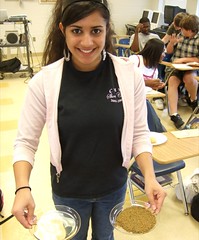
Zartar, a Middle Eastern spice, with olive oil and pita bread, as served by Jinan Halim, Shreveport
Originally uploaded by trudeau
Typically eaten with olive oil on pita bread.
Jinan Halim recently introduced the snack to her geography class.
Independent work for bonus credit
Independent work topics . . .
Research and compare (both sims & difs). Don't forget
- titling.
- vivid opening.
- blending of topics.
- documentation via "according to ...."
- grammar and spelling.
a) falconry and camel racing.
b) the nations of Yemen and Saudi Arabia.
c) the Arabian horse and the Mustang.
d) yogurt and the date - of the date palm.
e) Ibn Battuta and Ibn Saud.
f) Compose a skit (group project) that will bring to life the biographies and teaching of Abraham, Muhammad and Jesus of Nazareth. You may be lighthearted but not blasphemous.
Research and compare (both sims & difs). Don't forget
- titling.
- vivid opening.
- blending of topics.
- documentation via "according to ...."
- grammar and spelling.
a) falconry and camel racing.
b) the nations of Yemen and Saudi Arabia.
c) the Arabian horse and the Mustang.
d) yogurt and the date - of the date palm.
e) Ibn Battuta and Ibn Saud.
f) Compose a skit (group project) that will bring to life the biographies and teaching of Abraham, Muhammad and Jesus of Nazareth. You may be lighthearted but not blasphemous.
Wednesday, October 10, 2007
Jewish breakfast or snack: bagels and lox
Yiddish: a language of Jewish ciulture that combines German plus Hebrew.
Some English words with Yiddish origins:
* bagel : a ring-shaped bread roll made by boiling then baking the dough.
* blintz : a sweet cheese-filled crepe
* chutzpah : guts, daring, audacity, effrontery (Yiddish חוצפּה khutspe, from Hebrew) (AHD)
* dreck : (vulgar) worthless material, especially merchandise; "crap" (Yiddish drek or German Dreck) (OED, MW)
* glitch : a minor malfunction (possibly from Yiddish glitsh) (AHD)
* goy : a gentile, someone not of the Jewish faith or people (Yiddish גוי, plural גוים goyim; from Hebrew גוים goyim meaning 'nations
* kibitz : to offer unwanted advice, e.g. to someone playing cards; to converse idly, hence a kibbitzer, gossip (Yiddish קיבעצן kibetsn; cf. German kiebitzen, related to Kiebitz 'lapwing') (OED, MW)
* klutz : clumsy person (from Yiddish קלאָץ klots 'wooden beam', cf. German Klotz) (OED, MW)
* kosher : conforming to Jewish dietary laws; (slang) appropriate, legitimate (originally from Hebrew כּשר kašer) (AHD)
* kvetch : to complain habitually, gripe; as a noun, a person who always complains (from Yiddish קװעטשן kvetshn 'press, squeeze', cf. German quetschen 'squeeze') (OED, MW)
* lox : smoked salmon (from Yiddish לאַקס laks 'salmon'; cf. German Lachs 'salmon') (OED, MW)
* maven : expert (from Yiddish מבֿין meyvn, from Hebrew mevin 'one who understands') (OED, MW)
* Mazel tov : congratulations! (Yiddish מזל־טובֿ mazl-tov, from Hebrew mazzāl ṭōv: mazzāl 'fortune' + ṭōv 'good')
* mensch : an upright man; a decent human being
* nebbish : an insignificant, pitiful person; a nonentity (from Yiddish interjection nebekh 'poor thing!', from Czech nebohý) (OED, MW)
* nosh : snack (noun or verb) (Yiddish נאַשן nashn, cf. German naschen) (OED, MW)
* oy : interjection of surprise, dismay, or grief (Yiddish אױ oy) (OED, MW)
* oy vey : interjection of grief, pain, or horror (Yiddish אױ װײ oy vey 'oh, pain!' or "oh, woe"; cf. German oh weh) (OED)
* plotz : to burst, as from strong emotion (from Yiddish פּלאַצן platsn 'crack', cf. German platzen) (OED)
* putz : an idiot, a jerk; a penis (from Yiddish פּאָץ pots) (AHD)
* schlemiel : an inept clumsy person; a bungler; a dolt (Yiddish shlemil) (OED, MW)
* schlep : to drag or haul (an object); to make a tedious journey
* schlock : something cheap, shoddy, or inferior (perhaps from Yiddish shlak 'a stroke', cf. German Schlag) (OED, MW)
* schlong : (vulgar) penis (from Yiddish שלאַנג shlang 'snake'; cf. German Schlange) (OED)
* schmaltz : melted chicken fat; excessive sentimentality (from Yiddish שמאַלץ shmalts or German Schmalz) (OED, MW)
* schmeer also schmear : noun or verb: spread (e.g., cream cheese on a bagel); bribe (from Yiddish שמיר shmir 'smear';
* schmooze : to converse informally, make small talk or chat (from Yiddish שמועסן shmuesn 'converse', from Hebrew shəmūʿōth 'reports, gossip') (OED, MW)
* schmuck : a contemptible or foolish person; a jerk; literally means 'penis' (from Yiddish שמאָק shmok 'penis') (AHD)
* schnook : an easily imposed-upon or cheated person, a pitifully meek person, a particularly gullible person (perhaps from Yiddish.
* schnoz or schnozz also schnozzle : a nose, especially a large nose (perhaps from Yiddish שנויץ shnoits 'snout', cf. German Schnauze) (OED, MW)
* shicker or shickered : drunk (adjective or noun) (Yiddish shiker 'drunk', from Hebrew šikkōr) (OED)
* shiksa : (often derogatory) a young non-Jewish woman (Yiddish שיקסע shikse, a derivative of the above שײגעץ sheygets) (AHD)
* shtetl : a small town with a large Jewish population in pre-Holocaust Eastern Europe (Yiddish שטעטל shtetl 'town', diminutive of שטאָט shtot 'city'; cf. German Städtl, South German colloquial diminutive of Stadt, city) (AHD)
* shtick : comic theme; a defining habit or distinguishing feature (from Yiddish שטיק 'piece'; cf. German Stück 'piece') (AHD)
* spiel : a sales pitch or speech intended to persuade (from Yiddish שפּיל shpil 'play' or German Spiel 'play) (AHD)
* tchotchke: knickknack, trinket, curio (from Yiddish טשאַטשקע tshatshke, from obsolete Polish czaczko) (OED, MW)
* tush : butt, rear end (from tuchus) (OED, MW)
* yarmulke : round cloth skullcap worn by observant Jews (etymology unclear) (OED, MW)
* yenta : a talkative woman; a gossip; a scold (from Yiddish יענטע, from a given name) (OED, MW)
* zaftig : plump, chubby, full-figured, as a woman (from Yiddish zaftik 'juicy'; cf. German saftig 'juicy') (OED, MW)
Some English words with Yiddish origins:
* bagel : a ring-shaped bread roll made by boiling then baking the dough.
* blintz : a sweet cheese-filled crepe
* chutzpah : guts, daring, audacity, effrontery (Yiddish חוצפּה khutspe, from Hebrew) (AHD)
* dreck : (vulgar) worthless material, especially merchandise; "crap" (Yiddish drek or German Dreck) (OED, MW)
* glitch : a minor malfunction (possibly from Yiddish glitsh) (AHD)
* goy : a gentile, someone not of the Jewish faith or people (Yiddish גוי, plural גוים goyim; from Hebrew גוים goyim meaning 'nations
* kibitz : to offer unwanted advice, e.g. to someone playing cards; to converse idly, hence a kibbitzer, gossip (Yiddish קיבעצן kibetsn; cf. German kiebitzen, related to Kiebitz 'lapwing') (OED, MW)
* klutz : clumsy person (from Yiddish קלאָץ klots 'wooden beam', cf. German Klotz) (OED, MW)
* kosher : conforming to Jewish dietary laws; (slang) appropriate, legitimate (originally from Hebrew כּשר kašer) (AHD)
* kvetch : to complain habitually, gripe; as a noun, a person who always complains (from Yiddish קװעטשן kvetshn 'press, squeeze', cf. German quetschen 'squeeze') (OED, MW)
* lox : smoked salmon (from Yiddish לאַקס laks 'salmon'; cf. German Lachs 'salmon') (OED, MW)
* maven : expert (from Yiddish מבֿין meyvn, from Hebrew mevin 'one who understands') (OED, MW)
* Mazel tov : congratulations! (Yiddish מזל־טובֿ mazl-tov, from Hebrew mazzāl ṭōv: mazzāl 'fortune' + ṭōv 'good')
* mensch : an upright man; a decent human being
* nebbish : an insignificant, pitiful person; a nonentity (from Yiddish interjection nebekh 'poor thing!', from Czech nebohý) (OED, MW)
* nosh : snack (noun or verb) (Yiddish נאַשן nashn, cf. German naschen) (OED, MW)
* oy : interjection of surprise, dismay, or grief (Yiddish אױ oy) (OED, MW)
* oy vey : interjection of grief, pain, or horror (Yiddish אױ װײ oy vey 'oh, pain!' or "oh, woe"; cf. German oh weh) (OED)
* plotz : to burst, as from strong emotion (from Yiddish פּלאַצן platsn 'crack', cf. German platzen) (OED)
* putz : an idiot, a jerk; a penis (from Yiddish פּאָץ pots) (AHD)
* schlemiel : an inept clumsy person; a bungler; a dolt (Yiddish shlemil) (OED, MW)
* schlep : to drag or haul (an object); to make a tedious journey
* schlock : something cheap, shoddy, or inferior (perhaps from Yiddish shlak 'a stroke', cf. German Schlag) (OED, MW)
* schlong : (vulgar) penis (from Yiddish שלאַנג shlang 'snake'; cf. German Schlange) (OED)
* schmaltz : melted chicken fat; excessive sentimentality (from Yiddish שמאַלץ shmalts or German Schmalz) (OED, MW)
* schmeer also schmear : noun or verb: spread (e.g., cream cheese on a bagel); bribe (from Yiddish שמיר shmir 'smear';
* schmooze : to converse informally, make small talk or chat (from Yiddish שמועסן shmuesn 'converse', from Hebrew shəmūʿōth 'reports, gossip') (OED, MW)
* schmuck : a contemptible or foolish person; a jerk; literally means 'penis' (from Yiddish שמאָק shmok 'penis') (AHD)
* schnook : an easily imposed-upon or cheated person, a pitifully meek person, a particularly gullible person (perhaps from Yiddish.
* schnoz or schnozz also schnozzle : a nose, especially a large nose (perhaps from Yiddish שנויץ shnoits 'snout', cf. German Schnauze) (OED, MW)
* shicker or shickered : drunk (adjective or noun) (Yiddish shiker 'drunk', from Hebrew šikkōr) (OED)
* shiksa : (often derogatory) a young non-Jewish woman (Yiddish שיקסע shikse, a derivative of the above שײגעץ sheygets) (AHD)
* shtetl : a small town with a large Jewish population in pre-Holocaust Eastern Europe (Yiddish שטעטל shtetl 'town', diminutive of שטאָט shtot 'city'; cf. German Städtl, South German colloquial diminutive of Stadt, city) (AHD)
* shtick : comic theme; a defining habit or distinguishing feature (from Yiddish שטיק 'piece'; cf. German Stück 'piece') (AHD)
* spiel : a sales pitch or speech intended to persuade (from Yiddish שפּיל shpil 'play' or German Spiel 'play) (AHD)
* tchotchke: knickknack, trinket, curio (from Yiddish טשאַטשקע tshatshke, from obsolete Polish czaczko) (OED, MW)
* tush : butt, rear end (from tuchus) (OED, MW)
* yarmulke : round cloth skullcap worn by observant Jews (etymology unclear) (OED, MW)
* yenta : a talkative woman; a gossip; a scold (from Yiddish יענטע, from a given name) (OED, MW)
* zaftig : plump, chubby, full-figured, as a woman (from Yiddish zaftik 'juicy'; cf. German saftig 'juicy') (OED, MW)
The walled Old city, Jerusalem, showing Western wall of the ancient Temple as well as the Dome of the Rock
(help·info), Yerushaláyim; Arabic: القُدس (help·info), al-Quds)[ii] is the capital and largest city of Israel[2] in both population and area,[3] with 732,100 residents in an area of 126 square kilometers (49 sq mi).[1] Located in the Judean Mountains, between the Mediterranean Sea and the northern tip of the Dead Sea, the city has a history that goes back as far as the 4th millennium BC, making it one of the oldest cities in the world.[4] Jerusalem has been the holiest city in Judaism and the spiritual center of the Jewish people since the 10th century BC.[5] The city contains a number of significant ancient Christian sites and is considered the third-holiest city in Islam.[6]
The walled area of Jerusalem, which constituted the entire city until the 1860s, is now called the Old City, and was added to the List of World Heritage Sites in danger in 1982.[7] The Old City has been traditionally divided into four quarters, says wikipedia.org, although the names used today—the Armenian, Christian, Jewish, and Muslim Quarters—were only introduced in the early 19th century.[8]
Despite having an area of only 0.9 square kilometer (0.35 square mile),[9] the Old City is home to several sites of key religious importance: the Temple Mount and its Western Wall for Jews, the Church of the Holy Sepulchre for Christians, and the Dome of the Rock and al-Aqsa Mosque for Muslims.
The walled area of Jerusalem, which constituted the entire city until the 1860s, is now called the Old City, and was added to the List of World Heritage Sites in danger in 1982.[7] The Old City has been traditionally divided into four quarters, says wikipedia.org, although the names used today—the Armenian, Christian, Jewish, and Muslim Quarters—were only introduced in the early 19th century.[8]
Despite having an area of only 0.9 square kilometer (0.35 square mile),[9] the Old City is home to several sites of key religious importance: the Temple Mount and its Western Wall for Jews, the Church of the Holy Sepulchre for Christians, and the Dome of the Rock and al-Aqsa Mosque for Muslims.
Jerusalem - Church of Holy Sepulchre - Catholicon (Greek Orthodox Cathedral) Dome
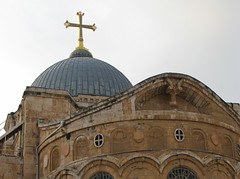
Jerusalem - Church of Holy Sepulchre - Catholicon (Greek Orthodox Cathedral) Dome
Originally uploaded by *Checco*
I s r a e l & A r a b i a / T r u d e a u
1. In Jerusalem this landmark lies south of the Church of the Holy Sepulcher and the Dome of the Rock as well as between them. a) Western Wall b) Via Dolorosa c) Citadel d) Damascus Gate.
2. He is thought of as the man who bridges the monotheistic religions: a) Jesus of Nazareth b) Abraham c) Prophet Muhammad d) King David.
3. This man is believed to have ascended into heaven from Jerusalem. a) Jesus of Nazareth b) Abraham c) Prophet Muhammad d) King David.
4. Unlike many of the world’s notable cities, Jerusalem is not located on a river. Over the centuries traders have had to depend on the city’s harbors on the Mediterranean Sea. T / F
5. Jerusalem is a city in which people observe _ sabbaths. a) 2 b) 3 c) 4 d) 5.
6. This region has been visited by the Holy Family, Lawrence of Arabia, Moses and numerous bandits: a) Negev Desert b) West Bank c) Nafud Desert d) Sinai Peninsula.
7. Syrup-soaked Middle Eastern pastry that is made from paper-thin sheets of phyllo dough and chopped nuts. a) Baklava b) Pita c) Hummus d) Tzatziki.
8. In Lawrence of Arabia the character Col. Brighton states why he thinks Great Britain is a great nation, though small in land, population and resources. It was a) Navy b) high-quality guns
c) brain power d) discipline.
9. In the desert the nomads make villages in dry canyons surrounded by rock walls. These places are called a) oases b) wadis c) dunes d) aquifers.
10. A permissible Jewish occupation in a Christian city:
a) usury b) slave trading c) scapegoat d) debtors.
11. Which of these sites is not a source but considered a portal, or entryway, into a world of sites referring to a particular topic? a) Yahoo.com b) Infoplease.com c) CIA.gov
d) Answers.com.
12. An exodus is similar to emigration, which is the same as a) dispersal b) immigration c) retribution d) extrication.
13. The pre-1948 name for today’s Israel: a) Palestine b) Lebanon c) Zion d) Ottoman Empire.
14. In chronological order: a) Judaism, Islam, Christianity
b) Christianity, Islam, Judaism c) Islam, Christianity, Judaism
d) Judaism, Christianity, Islam.
15. The Islamic feast of Rosh Hashanah is known as their New Year, or "head of the year," according to Wikipedia.org. No work may be done on Rosh Hashanah. T / F
16. What language has Lawrence learned, in addition to his mother tongue and French? a) Greek b) Arabic c) Hebrew d) Egyptian.
17. In Arabia there is a conflict between the tribal Bedouin peoples and the Turks. Their empire, which includes Arabia, is called the __ Empire.
a) Prussian b) Turkic c) Ottoman d) Egyptian.
18. In 1915 the top British priority in the Mid East was protection of a waterway important to their shipping and movement of warships.
a) Suez Canal b) Red Sea c) Arabian Sea d) Persian Gulf.
19. In the early 1900’s the city at the center of Islamic art, business and scholarship was not Mecca, nor Cairo. It was the capital of Syria. a) Damascus b) Beirut c) Medina d) Tel Aviv.
20. In the early phase of the movie Lawrence of Arabia the hero, TE Lawrence, resides in 3 nations. a) England, Egypt, Saudi Arabia b) England, Syria, Saudi Arabia c) England, Saudi Arabia, Israel d) England, Saudi Arabia, Iraq.
Tuesday, October 09, 2007
Deborah Morehead's lecture on village life in India
Mrs. Morehead, teacher of G / T 2nd year students in world literature, invited geography students to an illustrated lecture on her missionary trip to India.
Among the things students learned:
- village poverty (a dollar a day wages) and lack of sanitation.
- the struggle and competition for water.
- the oral culture of villagers in India.
- snake bite is a common killer in India.
- elephants and water buffalo share the road with trucks, cars, motorbikes and wagons.
- India is a land of many languages and dialects.
- both the monsoon season and the heat are difficult.
- the sari, shalwar kamiz, kurta, dona puddi and lungi (aka dhoti) are marvelous garments.
Students were fascinated by Mrs Morehead and were unusually attentive and affected by her talk.
Among the things students learned:
- village poverty (a dollar a day wages) and lack of sanitation.
- the struggle and competition for water.
- the oral culture of villagers in India.
- snake bite is a common killer in India.
- elephants and water buffalo share the road with trucks, cars, motorbikes and wagons.
- India is a land of many languages and dialects.
- both the monsoon season and the heat are difficult.
- the sari, shalwar kamiz, kurta, dona puddi and lungi (aka dhoti) are marvelous garments.
Students were fascinated by Mrs Morehead and were unusually attentive and affected by her talk.
Teaching a brief unit on Israel and neighbors; 10 pts.
Students worked on 2 maps of Israel in class Tuesday. They were part of a mini teaching unit.
a) the Big Picture map of Israel and neighbors, placing it between the Med and Red Seas as well as below Turkey and Greece and northeast of Egypt.
b) The Detailed map of Israel based on p. 25 in the RMQRWA. See a list of identifications in a previous post.
Students pulled 5 items of background on Israel from their class notes and atlas to complete the teaching package.
On the flip side of the page students are to have 5 multiple-choice questions. The unit is designed as a lesson and quiz for a parent or classmate.
10 pts. Packages to be completed in class Wed.
a) the Big Picture map of Israel and neighbors, placing it between the Med and Red Seas as well as below Turkey and Greece and northeast of Egypt.
b) The Detailed map of Israel based on p. 25 in the RMQRWA. See a list of identifications in a previous post.
Students pulled 5 items of background on Israel from their class notes and atlas to complete the teaching package.
On the flip side of the page students are to have 5 multiple-choice questions. The unit is designed as a lesson and quiz for a parent or classmate.
10 pts. Packages to be completed in class Wed.
Sunday, October 07, 2007
Baklava week, Oct 8 to 12 in the geography of Israel and SW Asia
Israel / Palestine and the complex cultural forces of this nexus is our theme this week. Our particular focus is the city of Jerusalem, holy to 3 great religions: Judaism, Christianity and Islam.
Map of Israel:
Med
Dead Sea
River Jordan
Tel Aviv-Yafo
Jerusalem
West Bank region
Gaza region
Negev desert
Egypt
Saudi Arabia
Jordan
Syria
Lebanon
Bethlehem
Nazareth
Sea of Gallilee
Mon.
review textbook material on Israel, pp. 439-447.
Tues.
Dome of the Rock mosque: holy to Muslims and Jews.
Wed.
The Western Wall of the Great Temple of the Jews: the Wailing Wall
Th.
Map quiz, Israel.
Fri.
The Church of the Holy Sepulchre and Christianity in Jerusalem.
Informal but printed-out progress reports should go out to all my classes on Monday. The 9 weeks grades will be tabulated at the end of the week.
The Class of 2011 Ride and Dine trip to homecoming has made its needed number of reservations, according to Mrs. Cindy Carson, chair of the 2011 Parent group. Congrats to the hard-working Mrs. Carson and fellow parents who have made it happen. More info at cwcarson@bellsouth.net.
Map of Israel:
Med
Dead Sea
River Jordan
Tel Aviv-Yafo
Jerusalem
West Bank region
Gaza region
Negev desert
Egypt
Saudi Arabia
Jordan
Syria
Lebanon
Bethlehem
Nazareth
Sea of Gallilee
Mon.
review textbook material on Israel, pp. 439-447.
Tues.
Dome of the Rock mosque: holy to Muslims and Jews.
Wed.
The Western Wall of the Great Temple of the Jews: the Wailing Wall
Th.
Map quiz, Israel.
Fri.
The Church of the Holy Sepulchre and Christianity in Jerusalem.
Informal but printed-out progress reports should go out to all my classes on Monday. The 9 weeks grades will be tabulated at the end of the week.
The Class of 2011 Ride and Dine trip to homecoming has made its needed number of reservations, according to Mrs. Cindy Carson, chair of the 2011 Parent group. Congrats to the hard-working Mrs. Carson and fellow parents who have made it happen. More info at cwcarson@bellsouth.net.
Saturday, October 06, 2007
Why tourists go to East Egypt today
Visitors dive to see the lush underwater scenery in the comely Red Sea.
That's the R e d Sea?
Yes, it is.
That's the R e d Sea?
Yes, it is.
Thursday, October 04, 2007
Mormon Missionaries: What is a Mormon?
The term "Mormon" has its origins from the Book of Mormon, which is believed by Latter Day Saints to be a collection of writings and teachings of the ancient prophets and followers of Jesus Christ who lived in the Americas from approximately 600 B.C. to A.D. 421. Mormons believe that Joseph Smith, Jr., says Wikipedia, translated the Book of Mormon into English by divine inspiration from golden plates that he received from the angel Moroni.
Mormons believe that the Book of Mormon is another scriptural witness of Jesus Christ that is comparable to the Bible, which they also believe to be the word of God.[1] The book gets its name from Mormon, the prophet who abridged the record during the 4th century.
Mormons believe that the Book of Mormon is another scriptural witness of Jesus Christ that is comparable to the Bible, which they also believe to be the word of God.[1] The book gets its name from Mormon, the prophet who abridged the record during the 4th century.
Wednesday, October 03, 2007
Islamic Empire map: 10 identifications and borders that range from Espana to Persia
1. Atlantic
2. Espana
3. Morocco
4. Egypt
5. Mediterranean
6. Arabia
7. Palestine (Israel)
8. Turkey (Asia Minor)
9. Persia (Iran)
10. Arabian Sea
2. Espana
3. Morocco
4. Egypt
5. Mediterranean
6. Arabia
7. Palestine (Israel)
8. Turkey (Asia Minor)
9. Persia (Iran)
10. Arabian Sea
Built about 690 CE, the Dome of the Rock is a shrine holy to both Muslims and Jews
The Dome of the Rock is an Islamic prayer house in what Muslims call Al-Aqsa Mosque, or the Noble Sanctuary — which Jews and Christians call the Temple Mount — it remains one of the best known landmarks of Jerusalem.
It was built between 687 and 691 by the 9th Caliph, Abd al-Malik, making it the oldest extant Islamic building in the world.
The rock in the center of the dome is the spot from which Muhammad ascended for a night-long journey to Heaven in AD 621, accompanied by the angel Gabriel. There he met many prophets like Abraham and Moses and was given the (now obligatory) Islamic prayers before returning to Earth (See Isra and Mi'raj). A Qur'anic verse says that Muhammad took an instantaneous night journey on Buraq from al-Masjid al-Haram ("the sacred mosque", interpreted as being in Mecca) to al-Masjid al-Aqsa ("the farthest mosque", interpreted as being in Jerusalem).[3]
In Judaism the stone is the site where Abraham fulfilled God's test to see if he would be willing to sacrifice his son Isaac (See Genesis 22:1-19). (Muslims believe that this event involved Abraham's other son Ishmael and occurred in the desert of Mina where millions of Muslims offer pilgrimage every year).
Situated inside the Holy of Holies, this was the rock upon which the Ark of the Covenant was placed in the First Temple.[4] During the Second Temple, the stone was used by High Priest who offered up the incense and sprinkled the blood of the sacrifices on it during the Yom Kippur Service. Rabbinic legend also alleges that the entire world was created from this stone, hence the name Foundation Stone.
It was built between 687 and 691 by the 9th Caliph, Abd al-Malik, making it the oldest extant Islamic building in the world.
The rock in the center of the dome is the spot from which Muhammad ascended for a night-long journey to Heaven in AD 621, accompanied by the angel Gabriel. There he met many prophets like Abraham and Moses and was given the (now obligatory) Islamic prayers before returning to Earth (See Isra and Mi'raj). A Qur'anic verse says that Muhammad took an instantaneous night journey on Buraq from al-Masjid al-Haram ("the sacred mosque", interpreted as being in Mecca) to al-Masjid al-Aqsa ("the farthest mosque", interpreted as being in Jerusalem).[3]
In Judaism the stone is the site where Abraham fulfilled God's test to see if he would be willing to sacrifice his son Isaac (See Genesis 22:1-19). (Muslims believe that this event involved Abraham's other son Ishmael and occurred in the desert of Mina where millions of Muslims offer pilgrimage every year).
Situated inside the Holy of Holies, this was the rock upon which the Ark of the Covenant was placed in the First Temple.[4] During the Second Temple, the stone was used by High Priest who offered up the incense and sprinkled the blood of the sacrifices on it during the Yom Kippur Service. Rabbinic legend also alleges that the entire world was created from this stone, hence the name Foundation Stone.
Abraham the Patriarch / Ibrahim the Prophet
Abraham (Ibrāhīm) is a figure in the Torah, Bible, and Quran whom Jewish, Christian and Muslim believers regard as the founding patriarch of the Israelites, Arabs and Edomite peoples, says Wikipedia.org.
According to the Torah, Abraham was brought by God from Mesopotamia to the land of Canaan, around 2000 BCE[1] There entered into a covenant: in exchange for sole recognition of Yahweh as supreme universal deity and authority, Abraham will be blessed with innumerable progeny.
His original name was Abram, meaning either "exalted father". For the latter part of his life, he was called Abraham, "father of many (nations)" per Genesis 17:5, although it does not have any literal meaning in Hebrew.[1]
Judaism, Christianity and Islam are sometimes referred to as the "Abrahamic religions", because of the role Abraham plays in their holy books.
In the Jewish tradition, he is called Avraham Avinu or "Abraham, our Father". God promised Abraham that through his offspring, all the nations of the world will come to be blessed (Genesis 12:3), interpreted in Christian tradition as a reference to Christ.
Jews, Christians, and Muslims consider him father of the people of Israel through his son Isaac (cf. Exodus 6:3, Exodus 32:13).
For Muslims, he is a prophet of Islam and the ancestor of Muhammad through his other son Ishmael.
According to the Torah, Abraham was brought by God from Mesopotamia to the land of Canaan, around 2000 BCE[1] There entered into a covenant: in exchange for sole recognition of Yahweh as supreme universal deity and authority, Abraham will be blessed with innumerable progeny.
His original name was Abram, meaning either "exalted father". For the latter part of his life, he was called Abraham, "father of many (nations)" per Genesis 17:5, although it does not have any literal meaning in Hebrew.[1]
Judaism, Christianity and Islam are sometimes referred to as the "Abrahamic religions", because of the role Abraham plays in their holy books.
In the Jewish tradition, he is called Avraham Avinu or "Abraham, our Father". God promised Abraham that through his offspring, all the nations of the world will come to be blessed (Genesis 12:3), interpreted in Christian tradition as a reference to Christ.
Jews, Christians, and Muslims consider him father of the people of Israel through his son Isaac (cf. Exodus 6:3, Exodus 32:13).
For Muslims, he is a prophet of Islam and the ancestor of Muhammad through his other son Ishmael.
Jerusalem - The Temple Mount - and conflict
The Temple Mount, also known as the Noble Sanctuary, is a religious site in the Old City of Jerusalem.
The Temple Mount is the holiest site for Judaism. The Jewish Temple in Jerusalem stood there: the First Temple (built c. 967 BCE, destroyed c. 586 BCE by the Babylonians), and the Second Temple (rebuilt c. 516 BCE, destroyed in the siege of Jerusalem by the Romans in 70 CE).
Known to Muslims as the Noble Sanctuary, it is also the site of two major Muslim religious shrines, the Dome of the Rock (built c. 690)and Al-Aqsa Mosque (built c. 710).
It is one of the most contested religious sites in the world.
Under the Jordanian rule of Eastern Jerusalem between 1948 and 1967, Jews were forbidden from entering the Old City. Both Israel and the Palestinian Authority claim sovereignty over the site, which remains a key issue in the Arab-Israeli conflict. The Israeli government has granted management of the site to a Muslim Council (Waqf).
en.wikipedia.org/wiki/Temple_Mount
The Temple Mount is the holiest site for Judaism. The Jewish Temple in Jerusalem stood there: the First Temple (built c. 967 BCE, destroyed c. 586 BCE by the Babylonians), and the Second Temple (rebuilt c. 516 BCE, destroyed in the siege of Jerusalem by the Romans in 70 CE).
Known to Muslims as the Noble Sanctuary, it is also the site of two major Muslim religious shrines, the Dome of the Rock (built c. 690)and Al-Aqsa Mosque (built c. 710).
It is one of the most contested religious sites in the world.
Under the Jordanian rule of Eastern Jerusalem between 1948 and 1967, Jews were forbidden from entering the Old City. Both Israel and the Palestinian Authority claim sovereignty over the site, which remains a key issue in the Arab-Israeli conflict. The Israeli government has granted management of the site to a Muslim Council (Waqf).
en.wikipedia.org/wiki/Temple_Mount
Our next unit: Israel and the Jews and Judaism
On page 25 in your RMQRWA is a detailed map of Israel. Please note these locations:
Lebanon
Syria
Jordan
Saudi Arabia
Egypt
Dead Sea
River Jordan
Mediterranean
West Bank region (disputed), formerly Judaea and Samaria
Gaza region
Jerusalem
Tel Aviv Yafo
Aqaba / Gulf of Aqaba
Sinai peninsula
Lebanon
Syria
Jordan
Saudi Arabia
Egypt
Dead Sea
River Jordan
Mediterranean
West Bank region (disputed), formerly Judaea and Samaria
Gaza region
Jerusalem
Tel Aviv Yafo
Aqaba / Gulf of Aqaba
Sinai peninsula
Six major peninsulas around the Med
The map sketched Wed, Oct 3 featured identification of six peninsular regions:
1. Iberian peninsula (Spain and Portugal)
2. Italian peninsula
3. Greek peninsula (see above)
4. Anatolian peninsula (Turkey)
5. Sinai peninsula (Egypt)
6. Arabian peninsula
The word is from the Latin. "Insula" means "island." "Paeninsula" means "almost an island."
This land form provides lots of coastline and, therefore, much room for harbors - and impetus for trade.
Does Louisiana have a similar advantage? In the Miss R and the Gulf of Mexico we derive opportunities for trade.
Does Shreveport have a land form advantage? The Red River valley has provided profit by trade in a bygone era. Today the US government and the Corps of Engineers have built a lock and dam system at a cost of billions. It has yet to provide the barge traffic and significant advent of factories and warehouses that would make jobs along the Red.
1. Iberian peninsula (Spain and Portugal)
2. Italian peninsula
3. Greek peninsula (see above)
4. Anatolian peninsula (Turkey)
5. Sinai peninsula (Egypt)
6. Arabian peninsula
The word is from the Latin. "Insula" means "island." "Paeninsula" means "almost an island."
This land form provides lots of coastline and, therefore, much room for harbors - and impetus for trade.
Does Louisiana have a similar advantage? In the Miss R and the Gulf of Mexico we derive opportunities for trade.
Does Shreveport have a land form advantage? The Red River valley has provided profit by trade in a bygone era. Today the US government and the Corps of Engineers have built a lock and dam system at a cost of billions. It has yet to provide the barge traffic and significant advent of factories and warehouses that would make jobs along the Red.
Tuesday, October 02, 2007
Vocab from Oct 2
An acquired taste - such as, perhaps, broccoli.
Halva (halvah) - the Arabic meaning is "sweet." A sugary, nutty paste that may be made with a variety of flours and nuts. Solomon Amiri, whose family is Persian, brought a halvah to his class. 'Twas yummy.
Yogurt - tangy, bacterially fermented milk from the Middle East.
There is evidence of cultured milk products being produced as food for at least 4,500 years, says Wikipedia. The earliest yoghurts were probably spontaneously fermented by wild bacteria living on the goat skin bags carried by the Bulgars (or Hunno-Bulgars), a nomadic people who began migrating into Europe in the 2nd century AD.
Today, many different countries claim yoghurt as their own, yet there is no clear evidence as to where it was first discovered.
The use of yoghurt by ancient Turks is recorded in the books Diwan Lughat al-Turk by Mahmud Kashgari and Kutadgu Bilig by Yusuf Has Hajib written in the 11th century. In both texts the word "yoghurt" is mentioned in different sections and its use by nomadic Turks is described. The first account of a European encounter with yoghurt occurs in French clinical history: Francis I suffered from a severe diarrhoea which no French doctor could cure. His ally, Suleiman the Magnificent, sent a doctor who allegedly cured the patient with yoghurt.
Until the 1900s, yoghurt was a staple in diets of the South Asian, Central Asian, Western Asian, South Eastern European and Central European regions.
The Russian biologist Ilya Ilyich Mechnikov had an unproven hypothesis that regular consumption of yoghurt was responsible for the unusually long lifespans of Bulgarian peasants. Believing Lactobacillus to be essential for good health, Mechnikov worked to popularise yoghurt as a foodstuff throughout Europe.
It fell to a Sephardic Jewish entrepreneur named Isaac Carasso to industrialise the production of yoghurt. In 1919, Carasso, who was from Salonika, started a small yoghurt business in Barcelona and named the business Danone ("little Daniel") after his son. Carasso emigrated to the United States during World War II and set up a business in New York City under an Americanised version of the name: Dannon.
Yoghurt with added fruit jam was invented to protect yoghurt from decay. It was patented in 1933 by the Radlická Mlékárna dairy in Prague, and introduced to the United States in 1947, by Dannon.
Halva (halvah) - the Arabic meaning is "sweet." A sugary, nutty paste that may be made with a variety of flours and nuts. Solomon Amiri, whose family is Persian, brought a halvah to his class. 'Twas yummy.
Yogurt - tangy, bacterially fermented milk from the Middle East.
There is evidence of cultured milk products being produced as food for at least 4,500 years, says Wikipedia. The earliest yoghurts were probably spontaneously fermented by wild bacteria living on the goat skin bags carried by the Bulgars (or Hunno-Bulgars), a nomadic people who began migrating into Europe in the 2nd century AD.
Today, many different countries claim yoghurt as their own, yet there is no clear evidence as to where it was first discovered.
The use of yoghurt by ancient Turks is recorded in the books Diwan Lughat al-Turk by Mahmud Kashgari and Kutadgu Bilig by Yusuf Has Hajib written in the 11th century. In both texts the word "yoghurt" is mentioned in different sections and its use by nomadic Turks is described. The first account of a European encounter with yoghurt occurs in French clinical history: Francis I suffered from a severe diarrhoea which no French doctor could cure. His ally, Suleiman the Magnificent, sent a doctor who allegedly cured the patient with yoghurt.
Until the 1900s, yoghurt was a staple in diets of the South Asian, Central Asian, Western Asian, South Eastern European and Central European regions.
The Russian biologist Ilya Ilyich Mechnikov had an unproven hypothesis that regular consumption of yoghurt was responsible for the unusually long lifespans of Bulgarian peasants. Believing Lactobacillus to be essential for good health, Mechnikov worked to popularise yoghurt as a foodstuff throughout Europe.
It fell to a Sephardic Jewish entrepreneur named Isaac Carasso to industrialise the production of yoghurt. In 1919, Carasso, who was from Salonika, started a small yoghurt business in Barcelona and named the business Danone ("little Daniel") after his son. Carasso emigrated to the United States during World War II and set up a business in New York City under an Americanised version of the name: Dannon.
Yoghurt with added fruit jam was invented to protect yoghurt from decay. It was patented in 1933 by the Radlická Mlékárna dairy in Prague, and introduced to the United States in 1947, by Dannon.
Subscribe to:
Posts (Atom)

